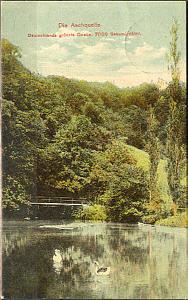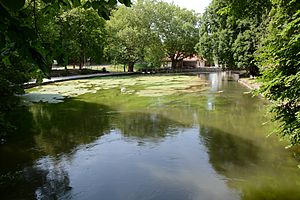Aachtopf facts for kids
The Aachtopf is Germany's biggest karst spring. It is located near the town of Aach. This amazing spring produces a huge amount of water, about 8,500 litres (over 2,200 gallons) every second! Most of this water actually comes from the River Danube. The Danube's water disappears underground at a place called the Danube Sinkhole. This sinkhole is about 12 to 14 kilometers north of the Aachtopf.
Contents
What's in a Name?
The name Aachtopf comes from two old words. Aach means "water" in Old High German. Topf means "bowl" or "pot". So, Aachtopf means "water bowl" or "water pot". This name fits well because the spring looks like a round, bowl-shaped pool.
Where is the Aachtopf?
The Aachtopf is a karst spring. It is found south of the western part of the Swabian Jura mountains. The spring is very close to the town of Aach. The water from the Aachtopf creates a river called the Radolfzeller Aach. This river flows south into Lake Constance. From there, its water eventually reaches the Rhine river.
How the Spring Works
The Aachtopf is the southern end of a large cave system. This system carries water from the western Swabian Jura. The spring produces about 8,500 litres of water every second. The amount of water can change with the seasons or weather. But the spring never dries up.
Most of the water comes from the Danube river. It disappears underground at the Donauversickerung, also known as the Danube Sinkhole. This happens near the towns of Immendingen and Fridingen. The Rhine river has a steeper path to the North Sea. This causes it to "capture" water from the Danube. Over a long time, the Danube might even disappear entirely in this area. Its water would instead flow into the Rhine.
It's quite strange: the Danube usually flows east towards the Black Sea. But the Rhine flows north towards the North Sea. This means the water from the Aach actually flows under the European watershed. This is a special line that divides river systems. It's common for karst springs to do this.
The karst spring is connected to a huge cave. This cave goes north and is completely filled with water. Only special cave divers can explore it.
Exploring the Aachtopf
People have been curious about the Aachtopf for a long time.
In 1719, a scientist named F. W. Bräuninger thought the spring's water came from the Danube. On October 9, 1877, a geologist named Adolf Knop proved this idea. He put 10 kg of a special dye (sodium fluorescein) into the Danube. He also added salt and oil. After 60 hours, he found all three in the Aachtopf! The water turned "splendidly green" and tasted salty.
In 1886, people tried to dive into the Aachtopf. This was one of the world's first cave dives. They went down 12 meters into a narrow part with strong water flow.
In 1960, a famous German cave diver, Jochen Hasenmayer, explored the cave. About 120 meters from the spring, the underwater passage opens into a large room called the "Seenhalle" (Lake Hall). A rockfall blocks the cave after 600 meters. Scientists believe the cave continues for several kilometers beyond this blockage.
In 1990, a local caving club started looking for the missing part of the cave. They dug a shaft behind the blockage. In 1995, they found a cavern 70 meters deep. They called it the Grey Hall. In 2003, they found another cavern with a lake. The group has made maps of this "Donauhöhle" (Danube Cave).
As of 2020, exploration is still happening. The full length of the cave has not yet been found.
Amazing Animals
In 2015, a special discovery was made. The only known cavefish in Europe was found in the Danube—Aachtopf system. It is a type of loach called a Barbatula.
Images for kids
See also
 In Spanish: Aachtopf para niños
In Spanish: Aachtopf para niños





